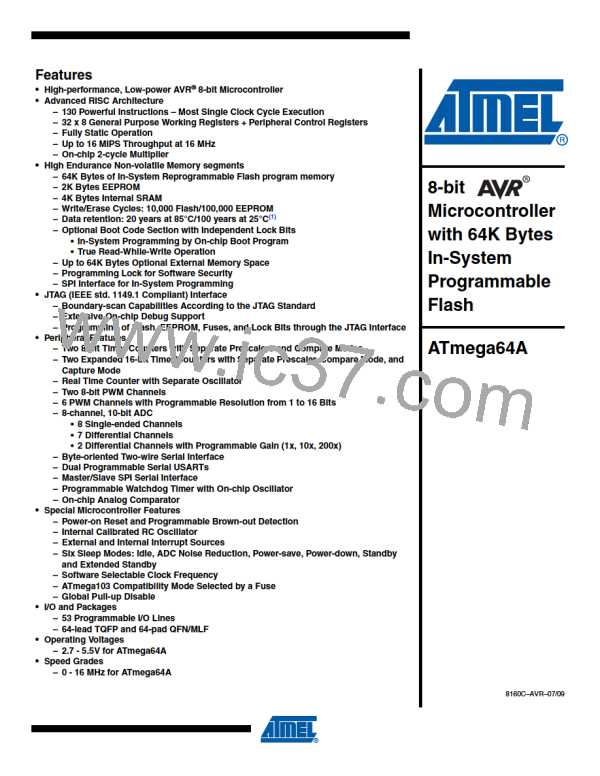ATmega64A
for power regulation, rectification, and DAC applications. High frequency allows physically small
sized external components (coils, capacitors), and therefore reduces total system cost.
In fast PWM mode, the counter is incremented until the counter value matches the MAX value.
The counter is then cleared at the following timer clock cycle. The timing diagram for the fast
PWM mode is shown in Figure 17-6. The TCNT2 value is in the timing diagram shown as a his-
togram for illustrating the single-slope operation. The diagram includes non-inverted and
inverted PWM outputs. The small horizontal line marks on the TCNT2 slopes represent Com-
pare Matches between OCR2 and TCNT2.
Figure 17-6. Fast PWM Mode, Timing Diagram
OCRn Interrupt Flag Set
OCRn Update and
TOVn Interrupt Flag Set
TCNTn
(COMn1:0 = 2)
(COMn1:0 = 3)
OCn
OCn
1
2
3
4
5
6
7
Period
The Timer/Counter Overflow Flag (TOV2) is set each time the counter reaches MAX. If the inter-
rupt is enabled, the interrupt handler routine can be used for updating the compare value.
In fast PWM mode, the compare unit allows generation of PWM waveforms on the OC2 pin. Set-
ting the COM21:0 bits to two will produce a non-inverted PWM and an inverted PWM output can
be generated by setting the COM21:0 to three (see Table 17-4 on page 159). The actual OC2
value will only be visible on the port pin if the data direction for the port pin is set as output. The
PWM waveform is generated by setting (or clearing) the OC2 Register at the Compare Match
between OCR2 and TCNT2, and clearing (or setting) the OC2 Register at the timer clock cycle
the counter is cleared (changes from MAX to BOTTOM).
The PWM frequency for the output can be calculated by the following equation:
f
clk_I/O
f
= -----------------
OCnPWM
N ⋅ 256
The N variable represents the prescale factor (1, 8, 64, 256, or 1024).
The extreme values for the OCR2 Register represents special cases when generating a PWM
waveform output in the fast PWM mode. If the OCR2 is set equal to BOTTOM, the output will be
a narrow spike for each MAX+1 timer clock cycle. Setting the OCR2 equal to MAX will result in a
constantly high or low output (depending on the polarity of the output set by the COM21:0 bits.)
153
8160C–AVR–07/09

 ATMEL [ ATMEL ]
ATMEL [ ATMEL ]